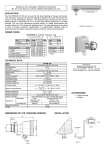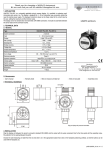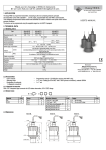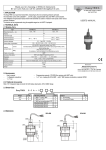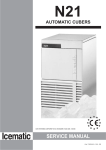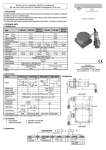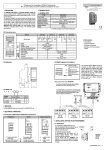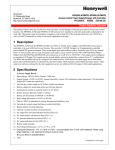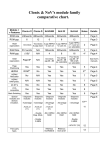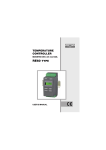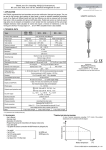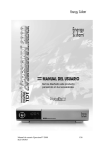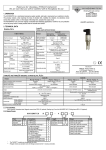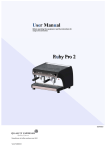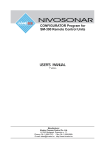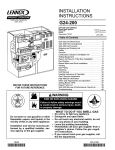Download pmg4111a0600h_01
Transcript
you for choosing a NIVELCO instrument. We are sure that you will be satisfied throughout its use. PMG-411, PMG-412, PMG-413 UNIVERSAL CONTROLLER 1. APPLICATION The UNICONT PMG-411, PMG-412 and PMG-413 universal analogue PID-controllers can be used with a Pt-100 resistance thermometer and with different thermocouples for temperature measurement, control as well as processing the signals of transmitters with 4…20 mA and 1…5 V DC or 0…10 V DC output. The output signal of the controller can be a relay, continous 4…20 mA process current signal or SSR-driver. Additional alarm relay provides for limit monitoring. The unit is microprocessor based, has an auto-tuning software, automatic and its PID controller able to find the optimum of the P-I-D constants. The setting can be performed by the keyboard on the front side. The large bi-coloured display provides easy reading even from far distance. The process parameters are red, the set values are green. USER’S MANUAL 2. TECHNICAL DATA Type PMG-411-; -412; -413 Resistance thermometer (3 cable, aut. cable compensation) DIN Pt 100 (–199.9 °C...+199.9 °C or 0 °C...+500 °C) R cable: max. 5 ohm Thermocouple (aut. cold junction compensator) Input Voltage Current PID (auto-tuning) Control output Output Alarm output Setting and display accuracy PV (process variable) Display SV (set value) Power supply Protection Electronic protection Ambient temperature Ambient humidity Dimensions Weight K (-100 °C…+1100 °C); J (0 °C…+800 °C) R (0 °C…+1700 °C); E (0 °C…+800 °C) T (-200 °C…+400 °C); S (0°C…+1700 °C) N (0 °C…+1300 °C); W (0 °C…+2300 °C) 1…5 V DC; 0…10 V DC 4…20 mA DC / 250 ohm Proportional range (P) 0…100% Integral time (I) 0…3600 s Derivative time (D) 0…3600 s Cycle time (C) 1…120 s Relay SPDT; 250 V AC, 3 A, AC1 SSR driver 12 V DC ±3 V, max. 30 mA Current 4…20 mA DC (max. load 600 ohm) SPST programmable relay, 250 V AC, 1 A, AC1 ±0,3 % ±1 digit for the whole input scale or ±3 °C 4 digit, 7 segment 11 mm high red LED 4 digit, 7 segment 7 mm high green LED 90…264 V AC 50/60 Hz, max. 5 VA Front side: IP 65, Back side: IP 20 Class II Reinforced Isolation Operational: -10…+50 °C, Storing: -20…+60 °C 35 … 85% RH 48 x 48 x 107 mm (panel cut out: 45.5+0,5 x 45.5+0,5 mm) 0.15 kg 2.1. ACCESSORIES Manufacturer: NIVELCO Process Electronics Co. Ltd. 1043 Budapest, Dugonics u. 11. Phone: 369-7575 ♦ Fax: 369-8585 e-mail: [email protected] http://www.nivelco.com 2.2. ORDER CODE 1 User’s Manual 1 Warranty Sheet 1 Declaration of Conformity 1 Fixing bracket, 2 screws UNICONT P M G - Input 1 Universal input 4 - 1 Code 1 Output 2 relays SSR driver 4…20 mA 2.3 FRONT PANEL 1 2 3 4 9 7 8 5 3. DIMENSIONS 6 1 PV: Process value display (red) 6 : Display setting keys 2 SV: Set value display (green) 7 EV1: Indicates the alarm output 3 SV2: If this LED is ON, the second, internal set point is effective. 8 OUT: Indicates the output 9 P/E key: Enters/ escapes programming 4 AT LED: Flashing during auto tuning 5 AT key: auto tuning operation Minimal distances on the front side min 55 min 62 Fixing bracket Code 1 2 3 4. WIRING US OUT IN1 AL1 IN2 : : : : : Power Supply Control Output Sensor Input Alarm Output Processor Input AL1 + Pt 100 TC IN1 10 9 8 7 5 4 12 6 OUT 1 IN1 PMG-411 Program menu can be entered by long and simultaneous pressing of the P/E and If no key is pressed within 20 s, factory setting (DEFAULT) will be returned. Alarm mode P/E PID control mode Alarm latch P/E P/E 2 6 10 AL1 SSR OUT 9 + Pt 100 8 TC 1 7 4 12 3 11 2 US + 4...20 mA OUT 1 PMG-413 keys (t > 3 s) Cooling or heating mode P/E 5 6 IN1 PMG-412 5. PROGRAMMING Selecting sensor + 3 11 7 US 4 12 8 TC 2 5 9 + Pt 100 3 11 10 AL1 US Upper measurement limit Measurement unit P/E P/E Lower measurement limit P/E Programming access lock P/E Selecting sensor P/E PROGRAM MENU Input Alarm mode Alarm latch PID control algorythm Cooling or heating control Engineering unit of the temperature measurement unit Upper measurement limit Lower measurement limit Programming access lock SETTING THE CONTROL PARAMETERS Control parameters can be entered by pressing key P/E longer than 3s Setting second (internal) set point. Effective with the short circuit of input IN2 Setting operation value of the alarm relay (if operation selected in EV-1 menu) Setting delay of the loop break indication relay output (0 … 999 s) (if operation selected in EV-1) Setting proportional band from 0 % to 100 % Setting integral time from 0 to 3600 s Setting derivative time from 0 to 3600 s Setting cycle time of the control relay from 1 to 120 s Setting switching difference from 0 to 100°C for ON/OFF control Modifying the measured value between -49 and +50 °C. Also applicable with calibration (OFFSET function) Setting proportional control range from 0 to 100 % (for control only) Setting rising gradient for RAMP mode if heating (setable range of time to reach the SV: 1 to 99 min) Setting rising gradient for RAMP mode if cooling (setable range of time to reach the SV: 1 to 99 min) Access lock If the access lock is active no parameter can be entered ON CHANGING THE SET POINT • Pressing key set value will be flashing the required parameter value can be set • Using key • Pressing key again the next parametern will be reached Confirm settings with the key P/E. OFF SETTING THE ON/OFF CONTROL • • • Set the PID parameters to zero The „HIS” code will be displayed. The switching difference can be set in this menu if needed. Measurement range : 0…100 °C or 0…10.0 °C, depending on the decimal point SELECT INPUT WITH MEAUREMENT RANGE DISPLAY ALARM RELAY DISABLING INPUT RANGE REMARKS YCA.H K thermocouple -100…+1300 °C YCA.L K thermocouple -100…+999 °C jic.h J thermocouple 0…+800 °C jic.l J thermocouple 0.0…+800.0 °C R thermocouple 0…+1700 °C E thermocouple 0…+800 °C E thermocouple 0.0…+800.0 °C T thermocouple -800…+400 °C T thermocouple -199.9…+400.0°C S thermocouple 0…+1700 °C N thermocouple 0…+1300 °C W thermocouple 0…+2300 °C J: Pt 100 0…+500 °C J: Pt 100 -199.9…+199.9°C DIN Pt 100 0…+500 °C DIN Pt 100 -199.9…+199.9°C 0 … 10 V DC -199.9 … +9999 1 … 5 V DC -199.9 … +9999 4 … 20 mA -199.9 … +9999 OPERATION DESCRIPTION Standard No latch Remains latched after triggering. Realese by selecting AL-A. No triggering at first reaching of PV SV. The output does not switch on if the PV first reaches the set point (SV). It triggers only if PV differs from the SV and reaches the alarm value. Simultaneous use of latching and standby order. Latch Reduced Standby Latch Decimal point Latch and Standby Decimal point SETTING THE ANALOGUE INPUT Decimal point Pushing both fasteners on the back side, the instrument can be pulled out of the box. There are two jumpers (S/W1 and S/W2) inside the instrument. The jumpers can be carefully pushed off and pulled back according to the figure below. A.) Resistance thermometer and thermocouple input B.) Voltage input (1 ... 5 V DC, 0 ... 10 V DC) Decimal point Decimal point Jumper setting and scaling are needed ALARM EVENTS Only the alarm event can be indicated on the display, which has been selected in menu Alarm Events. C.) Current input (4 ... 20 mA) SV-2 OPERATION (INTERNAL SET POINT) The SV can be seen on the lower green display and set by the keys on the front panel. There is a possibility to set a second internal SV in the SV-2 menu, which is effective with the short circuit of the input points IN2. — Current loop break — Sensor break MEASURED VALUE OFFSET (PARAMETER In-b) — Alarm relay failure Displayed value can be shifted with any value in the parameter In-b menu (Offset Function). This can be applied for instance for cable compensation with temperature measurement of two wire Pt 100. AL-1 SV PV exceeding the relative upper limit value. PV>SV+ AL1 SV PV exceeding the relative lower limit value. PV<SV- AL1 h AL-1 h AL-1 AL-1 h h PV is outside the range of the SV h PV is within the range of the SV SV AL-1 AL-1 h SV h SV AL-1 h AL-1 MODE SV Remark: „h” = 2 °C switching difference is fixed. PV exceeding the absolute upper limit value. PV>AL1 PV exceeding the absolute lower limit value PV<AL1 SCALING Measurement range will automatically be determined with the use of Pt 100 or thermocouple. For analogue inputs (4…20 mA, 0…10 V DC, 1…5 V DC) the low and the high values have to be entered in menu L-SC (low value) or H-SC (high value). SETTING RISING TEMPERATURE GRADIENT (RAMP) The required delay can be set in the rAPU menu for heating and in rAPd for cooling is needed. After reaching the new SV, will be kept by the controller. 6. CONTROL ALGORYTHM There are three different control algorythms, which can be set by the UNICONT PMG-411, -412 unit. • ON / OFF control • Proportional (P) control • PID control The best accuracy can be achieved by PID control. The PMG-413 unit with analogue output can only be used as PID controller. It is essential to define the control characteristic: whether heating or cooling is needed. COOLING/HEATING CONTROL The unit is able to control the cooling/heating process and it can also be used for level control. The filling control corresponds with the heating algorithm and the emptying control with the cooling algorithm. The algorithm can be selected in menu o-Ft. Select HEAT: heating or filling control • Select CooL: cooling or emptying control Y PV PV Y PID CONTROL The PID control is the most commonly used control mode. Similar to the proportional control PID control will be accomplished by changing the relay’s energized and de-energized states within its cycle time. Since determination of the PID parameters by the manual trial and error method the use of the AT mode is suggested. AT MODE Sensing charasteristic features of the control process, the unit determines automatically the PID parameters and the cycle time. AT mode will be started by pressing key AT at least 3 s. During the auto tuning the AT-LED will be blinking and it will turn off if completed. Auto tuning can be interrupted by pressing key AT for longer than 3 sec. Auto tuning procedure is suggested to repeat from time to time since thermal features may be changed. PID RAMPING MODES There are two different ramping modes With the first one, the PV reaches the SV with high speed. In this case a minor override will occur (Fig. 1.), by the second one the PV reaches the SV slower but without override (Fig. 2.) Selecting and setting can be performed in the Pidt menu. PidF means the fast and PidS the slow setting. t t Cooling/emptying SV Heating/filling PV = process variable S SV PV PV Y = control signal tx: Settle time S: Overshot SV: Settled value PV: Controlled value ON / OFF CONTROL Setting the PID parameters to zero the unit can be operating as an ON/OFF controller. In this case the controller offers a setable symmetrical switching difference in the menu HIS. The heating or cooling algorythm should be set (see menu o-Ft) PROPORTIONAL (P) CONTROL In case of proportional control the value of gain (P) is other than zero but the integral and derivative times are zero. The proportional gain can be set between 1…100%. Control will be accomplished by changing the time of the relay’ss enerized and de-energized state within the its cycle time. The cycle time of the relay can be set in the menu T between 1…120 s. Proportional band: the control range of the cycle. Out of the proportional band the relay is always energized or deenergized. The proportional baude: q = P (%) ⋅ ∆M where ∆M = measurement range. The location of the proportional band compared to the SV depends on the percentage value in the menu rESt. If rESt value = 0%, the whole range is under the SV. • If rESt value= 0 %, the whole band is under the SV. • If rESt value= 50.0 %, the proportional band is symmetrically situated to the SV • If rESt value = 100 %, the proportional band is situated over the SV tx tx: Settle time SV: Settled value PV: Controlled value tx PIdS PIdF 7. FAULT INDICATION The unit provides for fault indication if it does not work correctly. The fault indication can be a text on the display or triggering of the Alarm relay. Fault indications on the display There are three kinds of fault indiications: „LLLL” the measured value is under the lower measurement limit (it is probable an incorrect input choice) „HHHH” the measured value is over the upper measurement limit (the input signal has not been correctly choosen) „OPEN” the sensor input screw terminal is open (the wire is loose or cut) Fault indications by the Alarm relay The Alarm relay can be programmed for two alarm events. Selecting „LbA” Menu Point: In case of a unit failure the relay will be triggered with a delay set in Parametr Menu (See SETTING CONTROL PARAMETERS) Selecting „SBA” Menu Point: In case of sensor cut the relay will be triggered with a dely set in Parameter Menu (See SETTING CONTROL PARAMETERS) 8. STORAGE CONDITIONS Ambient temperature: -25...+60°C Air moisture: max. 98 % SV q q SV rESt = 0% R rESt = 50,0% R Relay operation depending on rEST percentage by proportional control 9. WARRANTY Warranty: two years after the purchase. It can only be validated if presenting both the warranty sheet and the invoice. The warrantial repair is carried out at the manufacturer’s seat so the costs of dismounting and mounting as well as the shipping charge the customer. The manufacturer accepts the instruments only accurately cleaned or desinfectioned. We do not guarrantee faults because of irregular use, break and elemental damage. pmg4111a0600h_01 April 2002. Nivelco reserves the right of technical changes.





